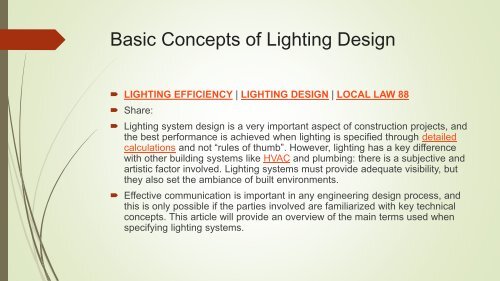Basic Concepts of Lighting Design | Electrical Engineer | MEP Design |
Lighting system design is a very important aspect of construction projects, and the best performance is achieved when lighting is specified through detailed calculations and not “rules of thumb”. However, lighting has a key difference with other building systems like HVAC and plumbing: there is a subjective and artistic factor involved. Lighting systems must provide adequate visibility, but they also set the ambiance of built environments. Effective communication is important in any engineering design process, and this is only possible if the parties involved are familiarized with key technical concepts. This article will provide an overview of the main terms used when specifying lighting systems.
Lighting system design is a very important aspect of construction projects, and the best performance is achieved when lighting is specified through detailed calculations and not “rules of thumb”. However, lighting has a key difference with other building systems like HVAC and plumbing: there is a subjective and artistic factor involved. Lighting systems must provide adequate visibility, but they also set the ambiance of built environments.
Effective communication is important in any engineering design process, and this is only possible if the parties involved are familiarized with key technical concepts. This article will provide an overview of the main terms used when specifying lighting systems.
You also want an ePaper? Increase the reach of your titles
YUMPU automatically turns print PDFs into web optimized ePapers that Google loves.
<strong>Basic</strong> <strong>Concepts</strong> <strong>of</strong> <strong>Lighting</strong> <strong>Design</strong><br />
LIGHTING EFFICIENCY | LIGHTING DESIGN | LOCAL LAW 88<br />
Share:<br />
<strong>Lighting</strong> system design is a very important aspect <strong>of</strong> construction projects, and<br />
the best performance is achieved when lighting is specified through detailed<br />
calculations and not “rules <strong>of</strong> thumb”. However, lighting has a key difference<br />
with other building systems like HVAC and plumbing: there is a subjective and<br />
artistic factor involved. <strong>Lighting</strong> systems must provide adequate visibility, but<br />
they also set the ambiance <strong>of</strong> built environments.<br />
Effective communication is important in any engineering design process, and<br />
this is only possible if the parties involved are familiarized with key technical<br />
concepts. This article will provide an overview <strong>of</strong> the main terms used when<br />
specifying lighting systems.
The Lumen: <strong>Basic</strong> Unit <strong>of</strong> Luminous<br />
Flux<br />
However, this leads to confusion when comparing different types <strong>of</strong><br />
lighting. For example, the lumen output is roughly the same for a 60W<br />
incandescent bulb, a 15W compact fluorescent light, and a 9W LED bulb.<br />
A common misconception about LED lighting is that you end up with a<br />
darker room due to the reduced wattage. However, this comes from the<br />
old practice <strong>of</strong> describing brightness with watts, when the correct unit is<br />
the lumen.<br />
The concept <strong>of</strong> luminous efficacy describes how efficiently a lamp<br />
converts watts <strong>of</strong> electricity into lumens, similar to the gas mileage (MPG)<br />
<strong>of</strong> a car. Assuming the three light bulbs described above produce 900<br />
lumens each, the luminous efficacy values would be the following:
The Lumen: <strong>Basic</strong> Unit <strong>of</strong> Luminous<br />
Flux<br />
Just like a car with a higher MPG value has a lower fuel cost for a given distance<br />
traveled, a light source with a higher lm/W value has a lower electricity cost for a given<br />
lighting output. Upgrading to LED lighting is one <strong>of</strong> the most cost-effective energy<br />
efficiency measures for a building.<br />
Lumens are useful when describing the output <strong>of</strong> a lamp or fixture, but a different<br />
measurement unit is required to describe the lighting needed by a specific area. For<br />
example, 10,000 lumens is more than enough lighting for a small <strong>of</strong>fice, but the effect is<br />
barely noticeable in a large warehouse.
Illuminance: Lumens per Unit <strong>of</strong> Area<br />
The concept <strong>of</strong> illuminance is used to describe the lighting required for a<br />
given occupancy, regardless <strong>of</strong> size. There are two common measurement<br />
units:<br />
Lux, or lumens per square meter.<br />
Foot-candle (fc), or lumens per square foot.<br />
1 fc = 10.7639 lux<br />
Since illuminance is specified per unit <strong>of</strong> area, room size does not matter.<br />
For example, an illuminance <strong>of</strong> 50 fc has the same meaning for a 500 sq.<br />
ft. <strong>of</strong>fice and for a 2500 sq. ft. <strong>of</strong>fice, with the difference that more lighting<br />
fixtures are required for the larger <strong>of</strong>fice.<br />
In actual lighting design, the illuminance level varies due to the spacing <strong>of</strong><br />
fixtures and their beam shapes. However, slight variations are acceptable<br />
as long as no areas are too dark or too bright.
Photometry: What is the Beam Shape<br />
<strong>of</strong> Lamps and Fixtures?<br />
Light beam shape is another important aspect considered by lighting<br />
designers. For example, spotlights concentrate their output into a narrow<br />
beam facing downwards, while tr<strong>of</strong>fers in <strong>of</strong>fices spread their output over<br />
the largest possible area to achieve uniform lighting.<br />
Do not assume that two light bulbs can be used for the same application<br />
just because their bases have the same shape. Using a light source with<br />
the wrong beam shape yields poor results even if the lumen output is<br />
calculated correctly.<br />
The beam shape <strong>of</strong> a lamp or fixture is threedimensional,<br />
and product models used in lighting<br />
design s<strong>of</strong>tware include this information for<br />
simulation purposes. On the other hand, a 3D beam<br />
shape cannot be represented in technical<br />
specifications; the beam is described with<br />
overlapping 2D figures that represent beam shape<br />
parallel and perpendicular to the light source.
Correlated Colour Temperature and<br />
Colour Rendering Index<br />
Describing the colour performance <strong>of</strong> lighting requires two separate<br />
metrics, one for the light source and another for the objects it illuminates.<br />
The correlated colour temperature (CCT) describes the colour <strong>of</strong> the<br />
light source itself. When dealing with the CCT, no value is considered “the<br />
best”, since each lighting hue has different applications.<br />
The colour rendering index (CRI) describes how faithfully the light<br />
source renders the colours <strong>of</strong> objects and surfaces in the room. The<br />
maximum CRI value is 100, describing a light source that matches the<br />
quality <strong>of</strong> natural light - a higher CRI is always better regardless <strong>of</strong> the<br />
application.
Using Temperature Values To<br />
Describe <strong>Lighting</strong> Colour<br />
Objects glow in a characteristic colour depending on their temperature,<br />
and this is why lava from a volcano looks red. The same principle applies<br />
to stars, where a yellow star like the Sun is hotter than a red star, and a<br />
blue star is hotter than a yellow one. In physics, this behaviour is<br />
described by an abstract concept called a “black body”, which is an object<br />
that emits no light except when heated, and each temperature<br />
corresponds with a specific colour glow.<br />
Light sources are not heated to the temperature implied by their CCT<br />
value, but it is a convenient way to assign a numerical value to their<br />
colour. In most residential and commercial applications, the CCT value <strong>of</strong><br />
lighting ranges from 2700K (yellowish white) to 6500K (bluish white). In<br />
other words, if a light product has a CCT <strong>of</strong> 4000K, it means it glows with<br />
the same colour as a “black body” at 4000K, but the light source itself does<br />
not reach that temperature!
Using Temperature Values To<br />
Describe <strong>Lighting</strong> Colour<br />
Low colour temperatures like 2700K are perceived as “warm” and they<br />
tend to have a relaxing effect. They are preferred in areas like residential<br />
bedrooms, hotel rooms and high-end restaurants. Warm colours are not<br />
well suited for commercial and industrial settings, where the relaxing effect<br />
can be counterproductive.<br />
High colour temperatures like 6500K are perceived as “cool” and they tend<br />
to have an energizing effect, enhancing. They are preferred in applications<br />
where maximum visibility is required, such as high-precision<br />
manufacturing. Cool colours may delay sleep when used in residential and<br />
hospitality settings, and extended exposure may be described as<br />
“stressful” by some individuals.
Effect <strong>of</strong> the Light Source on Objects<br />
and Surfaces<br />
Even if two light sources have the same CCT value, their lighting quality<br />
may differ. A CRI value <strong>of</strong> 100 means the light source is a good as<br />
sunlight.<br />
Despite their inefficiency, incandescent and halogen bulbs <strong>of</strong>fer a CRI <strong>of</strong><br />
100.<br />
Fluorescent bulbs tend to have the lowest colour rendering performance,<br />
and low-tier products can go below 70.<br />
CRI values for LED bulbs can vary significantly depending on product<br />
quality. Low-end products go below 70, while high-performance products<br />
reach values close to 100.<br />
The minimum CRI for a light bulb to get the ENERGY STAR label is 80.
Conclusion<br />
LED upgrades have the potential to reduce lighting power consumption by<br />
over 50 percent. If the space is air-conditioned, indirect savings are<br />
achieved by reducing the heat footprint <strong>of</strong> lamps and fixtures. It can be<br />
tempting to simply swap the existing lighting with the most efficient product<br />
available, but lighting design must not be overlooked - lighting savings<br />
should not be achieved at the expense <strong>of</strong> quality.<br />
If your property is covered by Local Law 88, you must upgrade your<br />
lighting to meet the NYC Energy Conservation Code by 2025. However,<br />
you can achieve a better return on investment by exceeding the efficiency<br />
level required, while also using the chance to improve lighting quality.




